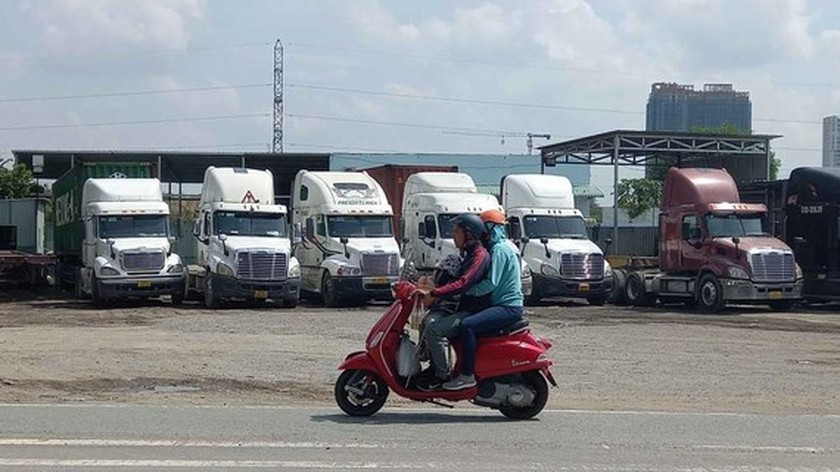 A parking lot in Thu Duc City
A parking lot in Thu Duc City
Vo Chi Cong Street in Thu Duc City is quite narrow, but at peak hours, especially noon and evening, container trucks are still parked almost all the way.
One afternoon in early November, at Ba Cua Bridge area in Binh Trung Dong ward in Thu Duc City, many heavy trucks and container trucks were parked in rows on Vo Chi Cong Street, blocking the view and leading to dangers for drivers.
Due to the severe shortage of parking lots, many people have set up spontaneous parking lots without ensuring safe conditions.
Only a section of about 1km in Vo Chi Cong Street, dozens of parking lots have been spontaneously established along the road.
In front of each parking lot, a billboard is placed saying that the owner of the parking lots receives all vehicles even at prohibited hours with the price of VND100,000. In addition to parking, many parking lots also provide other services such as car wash, repair, and oil changes...
However, most of these illegally-established parking lots are not equipped with fire prevention and fighting equipment and systems and they don’t abide by the present regulations of the environment.
Furthermore, there is a sign prohibiting trucks over 3.5 tons per hour at the Phu Huu roundabout in Nguyen Duy Trinh Street, but container truck drivers still blatantly parked on the roadway, not according to the prescribed time frame every day.
A 38-year-old truck driver, Le Van Hai, who parked his car at a parking lot on Vo Chi Cong Street, said that he could park in the street because the car owner registered and paid in advance monthly.
It is very difficult for passing cars to find a place to park in the parking lot because the demand is so great. Many drivers can't find parking, have to run around, or risk their lives to park on the roadway, Hai revealed.
Worse, it is more difficult to find a parking space in the downtown area of Ho Chi Minh City, especially for cars. Because of the lack of parking space, many roads suddenly turned into parking lots.
On the two routes Han Thuyen and Alexandre de Rhodes in District 1, there are always cars parked in long lines on the roadway, despite the forbidden sign.
Meanwhile, there are signs prohibiting parking in the streets like Pasteur, Ngo Thoi Nhiem, and Truong Dinh in District 3, but many drivers still turn on emergency lights to stop to avoid penalties from the authorities.
Hoang The Nam, a driver for a business in Tan Binh District, moaned that every time he drives my boss to District 1 to meet customers, he faces difficulties in finding a parking space.
Many times, he ran for an hour in District 1 and still couldn't find a place to park, so he had no choice but to turn on the emergency lights to park on the street despite knowing that parking like that is against the traffic laws.
The lack of parking space not only makes it difficult for car owners and drivers but also negatively affects society.
When businesses pay large parking fees, it will push up the prices of goods and services, resulting in customers and consumers receiving enough. In addition, a lack of parking spaces results in on-street parking contributing to traffic congestion and traffic jams.
According to competent agencies’ latest statistics, the total number of vehicles in Ho Chi Minh City is nearly 9 million currently excluding millions of non-current vehicles that are circulating daily in the largest city in this country.
These are huge numbers, directly putting pressure on urban traffic in general and the static traffic network (wharf) in particular. Many people in Ho Chi Minh City are fatigued with finding a parking place for cars when they have to drive into the city’s downtown area.
To solve the problem of lack of parking space, the city's functional departments have planned and implemented a number of underground parking projects in the past time, allowing toll parking on 23 central streets.
However, more than a decade has gone by, these underground parking projects are still on paper.
According to Mr. Bui Van Quan, Chairman of the Ho Chi Minh City Cargo Transport Association, most businesses have resorted to renting vacant land lots as temporary parking lots; however, they suffered high rent plus a risk of fire and explosion but they can’t afford the fee in areas planned for parking.
Therefore, the most feasible solution is that the state must set aside public land funds for public transport because, in the current high land price context, only the state can handle it.
In addition, the land location for parking must meet the following criteria including a consensus between the transport unit and the organization or individual that has land use rights.
Source: SGGP